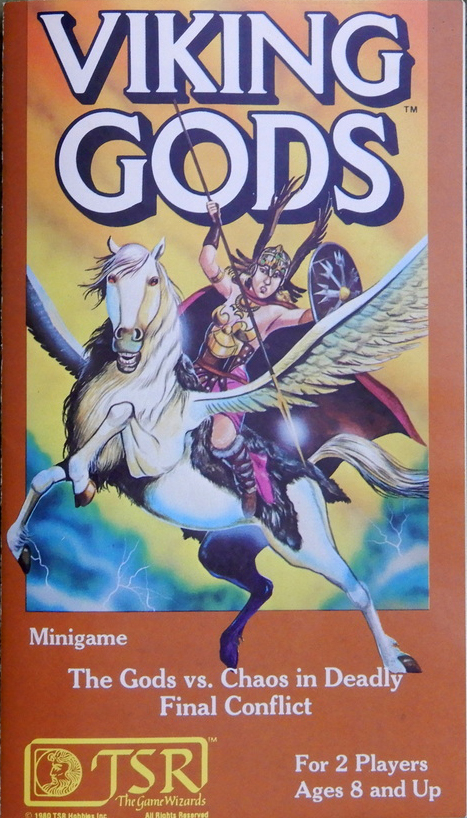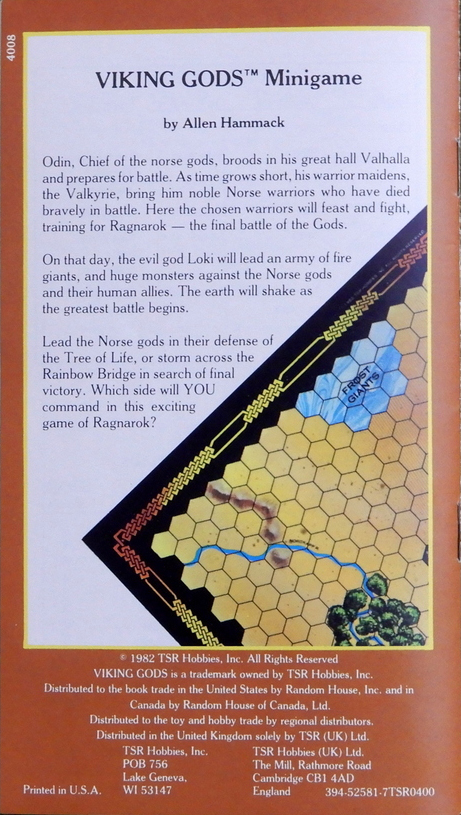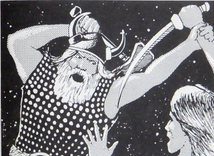Viking Gods: Big battles on a small scale
In many ways the early 1980s were the heyday of classic microgames, also called minigames, with the popularity of such games as Car Wars and Revolt on Antares, but those were far from the only games available. For instance, TSR Inc. made its fair share of microgames, including Viking Gods.
Published in 1982, Viking Gods allowed players to take part in the battle to end all battles, Ragnarok. A game for two players, one player took the side of the Forces of Chaos while the other player was in control of the Gods of Asgard. Each side in the battle had a mission. The job of the Forces of Chaos was to storm across the Rainbow Bridge and destroy Yggdrasil, the sacred tree. The side of the gods had the job of either killing Loki or destroying his army while defending the tree.
A somewhat simple war game, Viking Gods still packed lots of combat. All you needed were the included map, the game pieces, and a pair of six-sided dice. When it was their turn, players were allowed to move their cardboard pieces two spaces across a map until they came up against enemy forces. Then combat could begin. Using the combat chart at the bottom of the map, the dice were rolled to determine the outcome of battle. Depending upon that outcome, forces could be pushed back a space or they could be defeated, wiped out. Another option was the battle could lead to a draw.
More importantly to combat, each piece on the board had different strength levels for fighting, plus special abilities. For instance, Thor was one of the most powerful pieces in the game with five Strength Points, plus he had a +1 on his attacks against Jormundangdr, the Midgard Serpent.
To make matters a little more interesting, there were seven different types of terrain on the map: Hill, Woods, Glacier, Clear, River, Rainbow Bridge, and Hela’s Start. The rules for Viking Gods offered Basic game play and Advanced rules, with the terrain really only mattering with those Advanced rules.
Viking Gods was enjoyable to play back in the day, and I wish I still had my old set. My memory might not be what it used to be, but I do seem to recall enjoying Viking Gods though it did have some faults. For one thing, the combat chart with the map didn’t always seem to make sense, so I was left wondering if there had been a misprint or some other mistake … or maybe I was just dense.
One issue I did have with Viking Gods was that it was only for two players. While that’s not a major problem, I did prefer games in which more than two people could play. But that’s really a minor issue.
Another issue was that since each of the play pieces had special abilities, one had to constantly look back to the rules to find out what those special abilities were. This could be time consuming and annoying, though I suppose those abilities would become familiar after playing the game a lot.
Designed by Allen Hammack, Viking Gods proved a lot of fun, but that’s to be expected from a game designer involved with early Dungeons & Dragons, especially Hammack’s work on the game module The Ghost Tower of Inverness. And with cover art by Jim Holloway, Viking Gods really stood out on store shelves.
Collectors of microgames would do themselves a favor and search the online auction sites and such for old copies of Viking Gods. And who knows? With all the reprints of old games going on today, maybe someone will bring out Viking Gods again.
Ty Johnston is vice president of the Rogue Blades Foundation, a non-profit organization focused upon bringing heroic literature to all readers. A former newspaper editor, he is the author of several fantasy trilogies and novels, including City of Rogues and The God Sword.





How did I not know that this ever existed? As far as I can tell, it didn’t even get a mention in Dragon Magazine.
Ty — oh man, now you’re really digging deep into the TSR archives!
I don’t think modern gamers can really fathom the huge impact the microgame revolution had on young gamers in the late 70s and early 80s. I was in high school at the time; I couldn’t afford the big box games (though I desperately wanted them).
But microgames were the same price as a paperback! And by the time TSR jumped into the market, microgames were where some of the most exciting and innovative developments were occurring — thanks mostly to the genius of a young Steve Jackson, who astounded the entire industry with the hugely fun and replayable OGRE. CAR WARS, and especially MELEE, WIZARD and DEATH TEST. Man, I spent a lot of hours with those games!
I was in late grade school and early Jr. high during that time period, and yeah, I miss the days of walking miles to the only game shop in my town and staring at the dozen or so microgrames available. Eventually we got a Waldenbooks, which had some D&D materials, but I don’t recall any microgames there.
Never knew about this one Ty. Looks like it was load of fun. I checked at Vassal and seems there is a Polish language version ported there called Ragnarok.
I think there was a German language version too, but I’m no 100 percent on that.